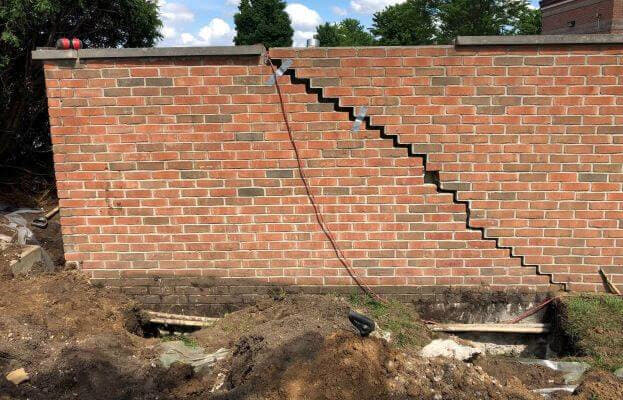
Originally posted 12/4/2018, updated 2/25/21
When you hear someone say, “my home’s foundation is sinking,” what comes to your mind? Do you imagine it sinking into water like a ship? Or do you picture a sinkhole that suddenly opens up and swallows the house?
In reality, it’s a tiny bit of both. Shifting earth and water are possible causes, but they don’t create sudden dramatic shifts in your home.
Acculevel has been repairing foundations and waterproofing homes since their start in 1996. A family-owned and operated company, we proudly serve Indiana and parts of the surrounding states. We restore homes to their previously healthy and secure condition, providing peace of mind to homeowners and helping them regain their home’s investment value.
We’re going to demystify the concept of a sinking foundation for you. We’ll explain the common causes of sinking, review the warning signs, and discuss the best repair methods available.
When your foundation was initially built, the ground below it should have been compacted. This means it was tamped down (flattened) as much as possible, to create a dense and level surface. Depending on what type of equipment is used, the compaction can be effective for as little as 3-4 inches, or up to 2 feet. But no matter how well compaction is done, there can still be some pockets of air within the soil.
Once your home is built and furnished, the weight of it presses against the ground. These little spaces in dirt shift or collapse, causing your home to settle or sink.
When water flows into the soil around your foundation, the dirt expands. If there is more water than the ground can absorb, it moves around, trying to seep into other places- like your foundation. This water pressure is called hydrostatic pressure, and it’s one of the leading causes of cracks and water leaks in your foundation.
When water moves around your foundation, it can undermine the dirt around your home. Sometimes it thoroughly erodes the soil under your home, other times it may only soften the soil. But whether the soil is too soft to support the house, or washed out significantly, the result is the same: it won’t properly support the weight of the house.
Droughts, floods and extremely cold temperatures also create problems for your foundation’s stability.
When damp soil freezes, it can form frost heaves or adfreezing. These both involve ice forming and damaging your foundation. When water freezes, it forms ice that expands in the soil below your home; this can push the foundation up and out of position. Then, when the ice melts, the lack of pressure lowers the foundation.
All this melting ice and snow, when combined with spring rains, can create floods. Flooding is a major source of damage, which we’ve already noted as a possible cause for your sinking foundation.
But did you know that a drought can also create foundation imbalances? When the soil around your home dries out, it begins to contract. This can pull dirt away from the foundation and undermine it, making it shift farther into the ground.
You need to look for small problems, that may seem like minor issues or a natural part of a home’s settling. These are symptoms that can be overlooked, if you don’t know their significance:
All of these issues occur because the foundation is no longer level. When one corner or side of your foundation sinks at a different rate than the rest, it strains the overall structure of the home. Building materials like concrete, steel, and wood are not flexible. This is why the doorframes or window casings start to cause sticking; they can’t bend to accommodate the shifts in the structure, so they get pulled out of plumb. Likewise, the concrete and drywall start to separate or crack.
To repair a sinking foundation, you need to install piers. These are steel posts that are driven into the ground around your home, then secured to your foundation with a steel bracket. Piers hold your foundation in place, so it cannot shift any lower. In some cases, the piers can actually lift your foundation up, closer to its original position.
Some contractors install push piers to accomplish these repairs. Acculevel firmly believes that helical piers are the best choice for residential homes, because helical piers do not use the weight of the building to reach the needed depth. Helical piers rely on the torque (force) of the stable soil far below the surface- which is measured by a pressure gauge.
If you have more questions about foundation repair, we have a thorough guide that explains all of the concepts in this article- in greater detail. Feel free to read just the sections that interest you, the entire guide, or even bookmark it for future use!
If you believe your home’s foundation is sinking and you’re ready for a professional evaluation, find an experienced and reputable contractor. We strongly recommend that you check the Better Business Bureau before you make any decisions; the BBB will help you determine if the contractor is accredited and insured. Please take advantage of our free checklist of questions you should ask a contractor, to ensure they are the right company for you.
If you live in our service area, please contact Acculevel. One of our experienced project managers will evaluate your foundation condition and recommend the best course of action for you, to keep your home strong and healthy for years to come.